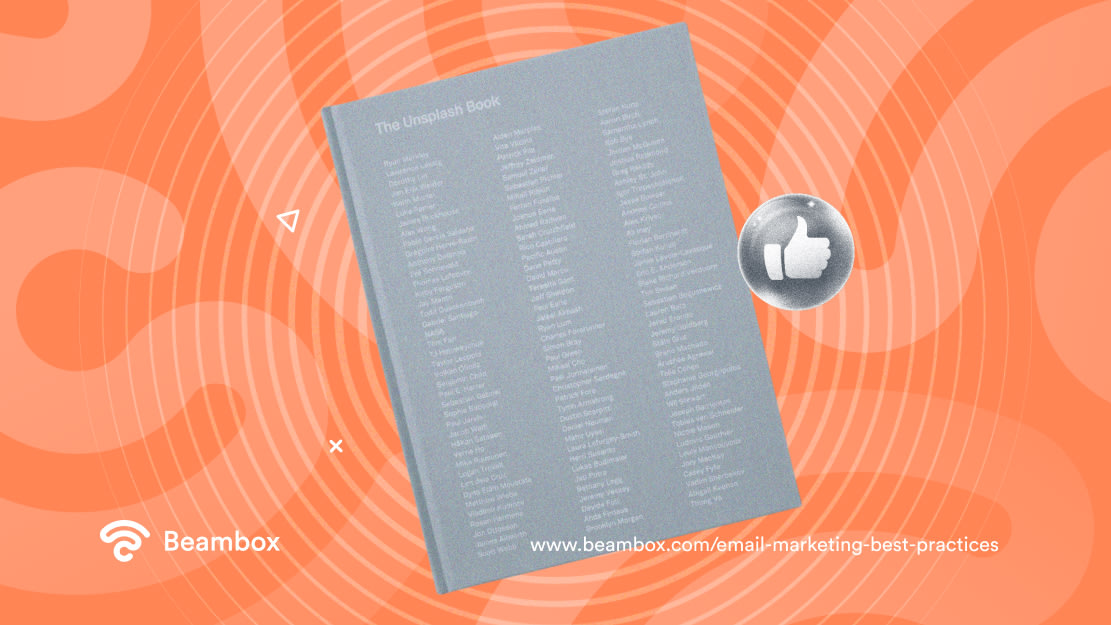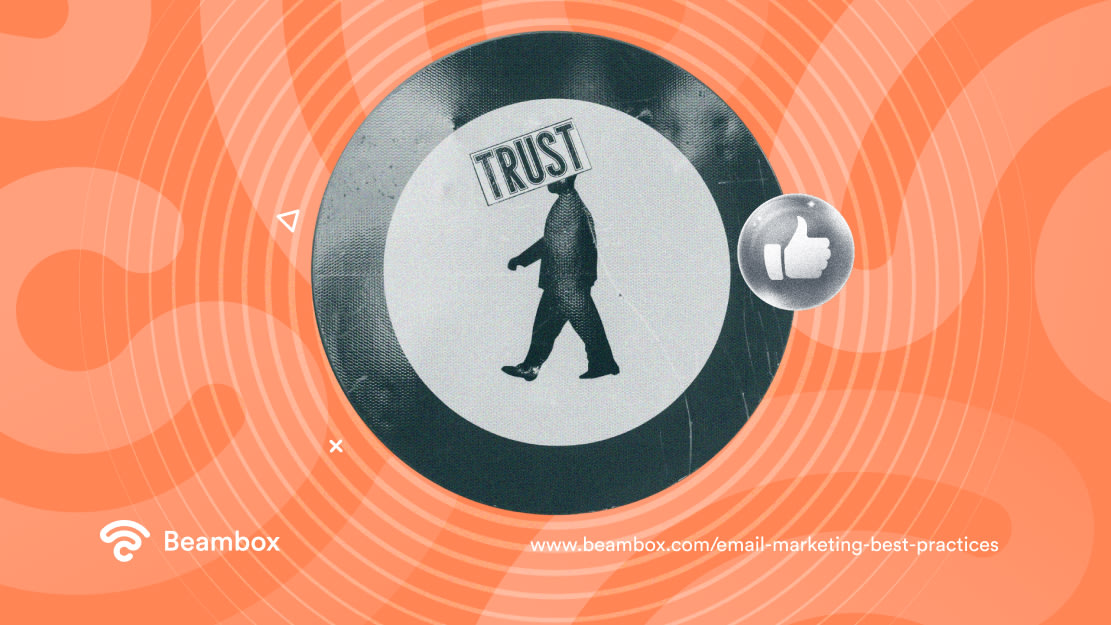Using email marketing to grow your business is the best decision you can make. However, it isn’t an easy one. Even the best offer fails when you don’t apply email marketing best practices.
Just when you think you’ve got everything under control, new rules and engagement tips enter the market. Therefore, businesses must always look for new ways to improve their email marketing strategy.
But let’s face it: it gets hard to juggle everything along with constant research. For this reason, we’ve created this guide with best practices for various aspects of email marketing.
So, if you’re ready to see your desired results, let’s start!

4 Email Marketing Best Practices for Targeting the Right Audience
Getting your emails right starts with getting your target audience right. That’s because your readers should feel like you’re talking directly to them.
Besides, not sending any emails is better than sending general emails. Customers who don’t find your emails relevant to their problems might get a bad impression. For example, families would show more interest in a restaurant’s kid-friendly menu and measures than lone diners.
So, here are four best practices for small business email marketing to help you target the right people.
1. Learn About Your Customers
The first step in email marketing for beginners is learning about your customers. Every business has a specific customer base. For example, beauty businesses won’t achieve much by attracting gaming enthusiasts, and vice versa.
Learning about your customers gives you insights into who you should try to attract. It also helps you position your emails in a way that appeals to them. In fact, any discussion about best practices for email marketing is incomplete without this tip.
So, start by conducting market research and learning how other similar businesses are reaching out to their customers. Use interviews, surveys, and focus groups. Your main goal should be to learn about their preferred communication channel, language, preferences, and interests.

2. Use Legal Methods To Build Your Email List
You’re wasting your efforts to learn about your customers if you send the emails to the wrong people. This will likely happen if you buy email lists instead of building and growing them organically.
These business email lists usually contain every email address the collector can find. There’s no saying whether those people are genuinely interested in your products or services.
So, use legal methods like pop-ups, social media campaigns, and WiFi marketing solutions to collect contacts. Gain explicit consent before sending emails. This will ensure that the email addresses belong to real people who want to hear from you.
3. Segment Your List To Create Buyer Personas
Every successful email campaign tries to achieve a specific goal. Some focus on increasing website traffic, while others aim to increase conversions.
However, all these goals fall under one collective objective: getting more clicks. That is only possible with personalization because it brings an impressive click-through rate (CTR) of 41%.
Sending general emails might work from time to time. But true success comes with personalization. For that, you must segment your list to create buyer personas.
So, start by separating the most loyal customers since they bring in the most revenue. You can also use audience research to determine which segments to pay the most attention to.
Moreover, segment your customers based on location, age, gender, behavior, and interests. This way, you can send personalized recommendations they can’t help but buy.

4. Remove Invalid, Unsubscribed, and Inactive Accounts
Building and forgetting about your email list will probably cause you more harm than good. You will need to remove inactive or unsubscribed email addresses.
Sometimes, people tire of a business’s emails due to various reasons. Some of these things are in your control, while others aren’t. For example, you can improve your tactics to win back people who unsubscribe due to irrelevant or uninteresting content.
However, you can’t do much about the people who no longer need your offerings. Other times, people just stop using an email address and create a new one.
But whatever the case, removing these email addresses will work in your favor. It will help you avoid wasting time and money on uninterested people and focus your efforts on engaged ones.

3 Best Practices for a Reputable and Trustworthy Email Address
Some businesses don’t see their desired results even when they do everything right. Spam filters might be the culprit if you’re in the same boat. These filters flag suspicious and harmful emails, sending them to spam folders instead of your recipient’s inbox.
But why are we discussing spam filters in a section dedicated to reputable and trustworthy email addresses? Besides spam triggers in subject lines and email content, your sender’s reputation also matters. That’s why we’ll discuss three best practices to help you maintain a stellar reputation.
1. Don’t Use a No-Reply Email Address
An impressive sender’s reputation starts with using the correct email address. A no-reply email address leaves customers few options for contacting you after reading an email. In this case, they resort to social media and other channels.
But why should they have to present their concerns about an email through other channels?
Not only does this provide a poor customer experience, but it also lowers their trust in you. The less your customers trust you, the more likely your emails are to go to spam folders.
Moreover, such one-way conversations can appear impersonal and raise suspicions. It can feel like you’re trying to hide behind a generic label, leaving less room for transparency. When that happens, your email deliverability will start to suffer.
Besides, it’s a fundamental requirement of CAN-SPAM, an email legislation you must comply with. So, ditch no-reply email addresses and use first names instead.

2. Use a Custom Domain
Just like using no-reply email addresses is not a good practice, using a personal one isn’t either. Instead, you must buy a custom domain to make your emails look professional.
When you use free domains, your emails will come across as marketing messages. However, the providers won’t be able to identify you as a business. This compromises transparency and stops your emails from reaching recipient inboxes. Consequently, having a custom domain shows that you’re serious about your email marketing strategy and builds trust among customers.
3. Choose a Memorable and Relevant Sender Name
As an extension to the previous point, choosing a memorable and relevant sender name is another tip worth following. Like subject lines, your sender name is a chance to make an excellent first impression.
If readers can’t recognize you by your name, they might ignore your emails. When they do this for the first few times, there’s no doubt about the backlash your future emails will face. Spam filters will start recognizing your emails as irrelevant and stop them from entering inboxes.
So, use your brand name to spark recognition, build trust, and raise awareness. If you have multiple domains, you can use something like “[brandname].support” or similar.
Another thing worth mentioning here is your sender information. Make sure you’re adding up-to-date and correct information about your business. Otherwise, you might have to face spam filters and legal troubles.
5 Tips To Create Email Content That Drives Results
Until now, we haven’t talked about email content. While things like reputation and email list best practices matter, you can’t ignore what you put in the email. If people don’t find your words interesting, nothing else can save your conversion rates.
However, a lot of things are under your control here. From subject lines to CTAs, everything works together to bring you the conversions you deserve.
For that, here are five content tips for you.
[PICTURE: https://www.pexels.com/photo/person-writing-on-a-notebook-beside-macbook-1766604/ - ALT: A woman writing something on a notebook with an open laptop, phone, and cup near her.]
1. Don’t Rush Your Subject Lines and Preheader Texts
When your emails reach your customers, the first thing they’ll see will be their subject lines. Preheader texts will come next. In addition to sender names, these are your chances of making a good first impression.
In fact, customers will use them to judge whether your email is relevant to them. That’s why following email subject lines best practices is important.
Don’t rush your subject lines. Make them interesting to spark the reader’s curiosity. You can even create a sense of urgency by using words like “last chance,” “limited-time offer,” and “for today only.” But remember, this doesn’t mean you can use spammy words.
Moreover, your subjects must match the email content. The same goes for preheader text. Make it match the subject line and email content. It should expand on the subject and give customers an idea of what’s coming.
2. Create Highly Engaging, Personalized Content
Moving on from subject lines to content, the most important tip is to personalize your emails. Everything else will be a waste of time if people don’t find your emails aligning with their needs.
However, personalization doesn’t end with approaching your customers with names. That’s become a standard practice - something customers expect from you. They now want you to go beyond that and anticipate their needs before emailing them.
So, use the buyer personas and segmentation to send highly engaging and personalized content. For example, you can send personalized recommendations based on past purchases.
Moreover, use storytelling to connect with your customers. Tell them how and why you started. Or you can share how other people found your products and services helpful.

You probably know what email marketing tools can do for automation. But do you know what else you can do with these tools? Design emails that catch the eye and are interesting to read.
These tools offer many pre-made templates that you can customize to fit your needs. That doesn’t mean you won’t have to do anything. Instead, you’ll have a good starting point with the proper structure and spacing. Therefore, invest in a good email marketing tool and leverage its capabilities for ease and effectiveness.
4. Understand the Importance of A/B Testing in Email Marketing
A/B testing in email marketing should be a requirement rather than a best practice. It’s just that potent. Here’s why.
It’s a process that compares the performance of two or more email campaigns. You divide your audience into groups and send a different version to each. Then, you use the one that brings the best results.
This means you’ll have actionable data on what you should and shouldn’t do. Instead of making guesses, you’ll know what your audience likes.
You have the freedom to choose what you want to test. It can be subject lines, preheader texts, buttons, or designs. However, it’s best to test one thing at a time so there’s no confusion.
5. Add Click-Worthy Calls-to-Action (CTAs)
Lastly, the best emails have the best CTAs. After all, you wouldn’t want customers to read your emails and not act on them. However, you can’t expect people to click on boring buttons or, worse, buttons that aren’t visible.
So, add a clear CTA at the end of your emails. You can even scatter multiple CTAs around the email. However, they shouldn’t be different. Each email campaign has one specific goal. Trying to achieve more with one email will do more harm than good.
Moreover, the text should be clear and concise. Don’t make your customers guess what their next steps should be. Also, place this text inside buttons instead of plain text or links. That will make the email CTA more prominent and drive better results.

3 Best Practices for Optimized Email Campaigns
Optimized email campaigns go beyond personalization and engaging content. The number and types of emails you send will determine your email marketing success.
Fortunately, best practices exist to help you cater to this aspect of email marketing as well. Everything is under your control here, from choosing the correct times to selecting the best metrics. All you have to do is pay attention, and you’re good to go. To help you with that, here are three best practices for optimized emails.
1. Select the Right Time and Frequency
When you’re sending emails to customers, there’s such a thing as the right time. Of course, the emails that reach customer inboxes will stay there unless the recipient deletes them. However, people are more active on emails during certain times than others. Studies reveal that this time is from 9 am to 11 am.
Besides, you wouldn’t want to send emails at night and risk looking unprofessional. Therefore, consider your customers’ time zones before hitting send.
Moreover, bombarding customers with frequent emails won’t do you any good. It might alert the spam filters and frustrate your customers. They probably never will if they don’t show interest in the first few emails. So, select the right frequency and number of emails.
2. Use Email Workflows To Guide Your Customer’s Journey
Customers no longer use a single channel to make buying decisions. They might hop from channel to channel, judging your brand and its relevance before deciding. Businesses that understand this have an upper hand on others.
That’s because they tailor the email workflows according to the customer journey. If customers have just discovered the business, run awareness or introductory campaigns. Similarly, if the customer is ready to make a purchase, they create a sense of urgency through discounts.
For optimized emails, you must follow in their footsteps. When customers get such relevant content, they feel guided. Honestly, that’s the best way to win customers and keep them from leaving.
3. Choose the Right Metrics
The last tip of this article is to choose the right metrics for tracking your email campaigns. Your work doesn’t end once you’ve sent the email. Now, you need to measure the results and see whether the campaigns fulfill their goals.
As mentioned multiple times, each campaign has a separate goal. So, choosing the right metrics will depend on that goal.
For example, if you’ve launched a campaign to increase website visitors, focus on CTRs. Other important metrics include open rates, bounce rates, forward rates, and conversion rates.
Personalization Isn’t Enough To Make Your Email Marketing Successful
Now you know that personalization isn’t the only thing to follow for email marketing best practices. A lot goes into marketing emails, from the sender’s reputation to choosing the right audience. So, use the categories in this article to guide your approach.
If you need help with your email marketing, try Beambox. Beambox can help you in your journey to email marketing success. Our tool makes it easy for businesses to collect contacts through a custom captive portal and run email campaigns.
Start your trial today!